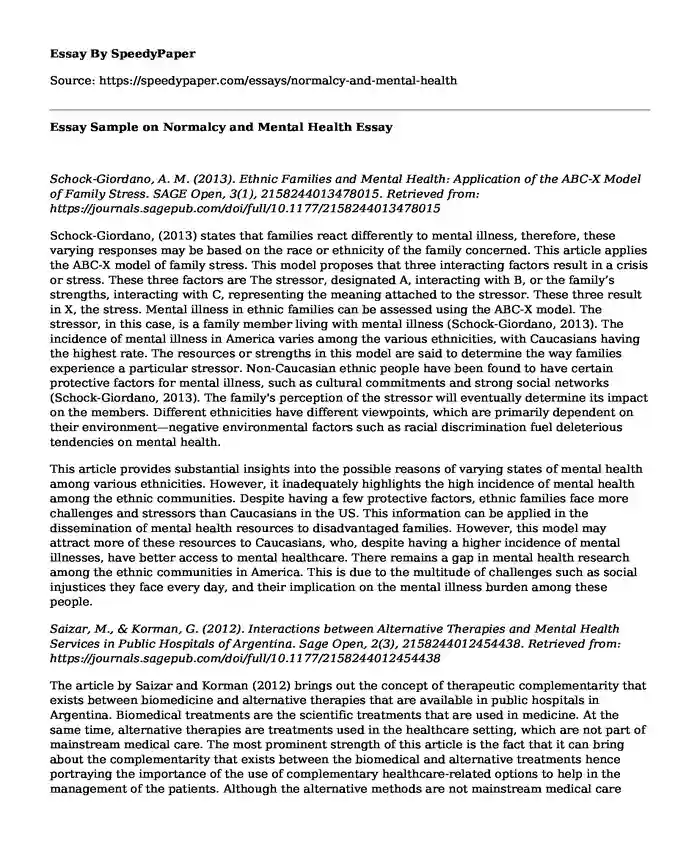
| Essay type: | Analytical essays |
| Categories: | Medicine Mental health Literature review |
| Pages: | 3 |
| Wordcount: | 759 words |
Schock-Giordano, A. M. (2013). Ethnic Families and Mental Health: Application of the ABC-X Model of Family Stress. SAGE Open, 3(1), 2158244013478015. Retrieved from: https://journals.sagepub.com/doi/full/10.1177/2158244013478015
Schock-Giordano, (2013) states that families react differently to mental illness, therefore, these varying responses may be based on the race or ethnicity of the family concerned. This article applies the ABC-X model of family stress. This model proposes that three interacting factors result in a crisis or stress. These three factors are The stressor, designated A, interacting with B, or the family’s strengths, interacting with C, representing the meaning attached to the stressor. These three result in X, the stress. Mental illness in ethnic families can be assessed using the ABC-X model. The stressor, in this case, is a family member living with mental illness (Schock-Giordano, 2013). The incidence of mental illness in America varies among the various ethnicities, with Caucasians having the highest rate. The resources or strengths in this model are said to determine the way families experience a particular stressor. Non-Caucasian ethnic people have been found to have certain protective factors for mental illness, such as cultural commitments and strong social networks (Schock-Giordano, 2013). The family's perception of the stressor will eventually determine its impact on the members. Different ethnicities have different viewpoints, which are primarily dependent on their environment—negative environmental factors such as racial discrimination fuel deleterious tendencies on mental health.
This article provides substantial insights into the possible reasons of varying states of mental health among various ethnicities. However, it inadequately highlights the high incidence of mental health among the ethnic communities. Despite having a few protective factors, ethnic families face more challenges and stressors than Caucasians in the US. This information can be applied in the dissemination of mental health resources to disadvantaged families. However, this model may attract more of these resources to Caucasians, who, despite having a higher incidence of mental illnesses, have better access to mental healthcare. There remains a gap in mental health research among the ethnic communities in America. This is due to the multitude of challenges such as social injustices they face every day, and their implication on the mental illness burden among these people.
Saizar, M., & Korman, G. (2012). Interactions between Alternative Therapies and Mental Health Services in Public Hospitals of Argentina. Sage Open, 2(3), 2158244012454438. Retrieved from: https://journals.sagepub.com/doi/full/10.1177/2158244012454438
The article by Saizar and Korman (2012) brings out the concept of therapeutic complementarity that exists between biomedicine and alternative therapies that are available in public hospitals in Argentina. Biomedical treatments are the scientific treatments that are used in medicine. At the same time, alternative therapies are treatments used in the healthcare setting, which are not part of mainstream medical care. The most prominent strength of this article is the fact that it can bring about the complementarity that exists between the biomedical and alternative treatments hence portraying the importance of the use of complementary healthcare-related options to help in the management of the patients. Although the alternative methods are not mainstream medical care approaches, they can have additional value, such as promoting good mental health, leading to increased well-being, and aiding in relaxation (Saizar & Korman, 2012). However, one of the most significant weaknesses of this article is the lack of mentioning that most of the alternative treatment methods used in Argentina and globally are not vetted; hence some of them usually result in unwanted adverse effects.
The information in this article is applicable in the field of mental health as it gives the insight on that although only biomedical therapies are legally authorized to be used in the management of patients, alternative practices have also found their way in both the private and public healthcare sector hence studies and quality control needs to be done to ensure the safety of patients. The implication for practice is that the vetting of the alternative methods will guarantee only those that are beneficial and safe for the patients are used to complement the biomedical therapies. Further studies are needed to determine the alternative practices in Argentina and globally to authorize those beneficial to the patient and eliminate those that are harmful or do not have clinical significance.
References
Saizar, M., & Korman, G. (2012). Interactions between Alternative Therapies and Mental Health Services in Public Hospitals of Argentina. Sage Open, 2(3), 2158244012454438. Retrieved from: https://journals.sagepub.com/doi/full/10.1177/2158244012454438
Schock-Giordano, A. M. (2013). Ethnic Families and Mental Health: Application of the ABC-X Model of Family Stress. SAGE Open, 3(1), 2158244013478015. Retrieved from: https://journals.sagepub.com/doi/full/10.1177/2158244013478015
Cite this page
Essay Sample on Normalcy and Mental Health. (2023, Oct 15). Retrieved from https://speedypaper.com/essays/normalcy-and-mental-health
Request Removal
If you are the original author of this essay and no longer wish to have it published on the SpeedyPaper website, please click below to request its removal:
- Free Essay: Gender and Sexuality in Catcher in the Rye and The House on Mango Street
- Free Essay Describing the Urinary Tract Infection Case
- Essay Sample on The Role of Family Nursing Practitioners
- Paper Example. Physiology of the Nervous System
- Essay Sample on Body Dysmorphic Disorder (BDD)
- Paper Example: Virgil, Dante and Underworld
- Addiction: Human Habits & Its Trauma Impacts - Essay Sample
Popular categories




